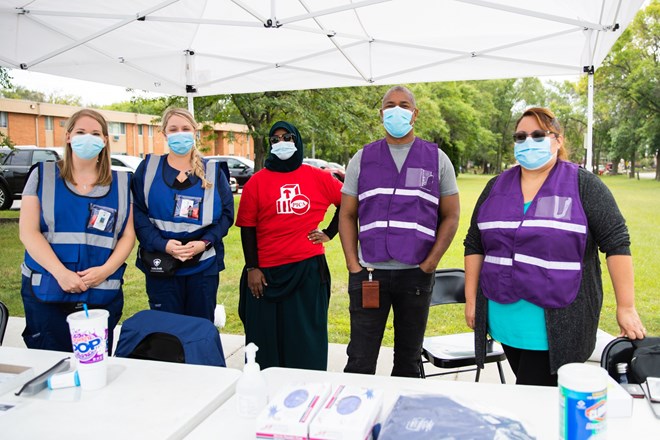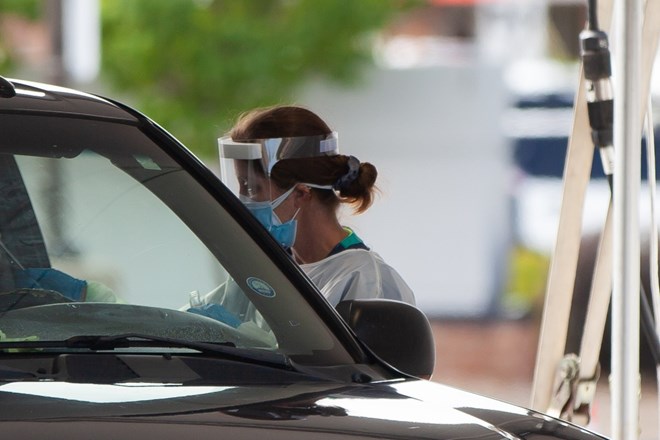
By JOEY PETERS
Thursday September 3, 2020
Communities of color are particularly at risk. The effort to reach them includes free testing, informal chats at the laundromat, broadcasts—and a lot more.

Nasro Mahamud, center, and Sammy Cuautle Pliego, far right, encouraged people from their respective communities to take free COVID-19 tests. Credit: Jaida Grey Eagle | Sahan Journal
Sammy Cuautle Pliego and five colleagues are sitting under a canopy on a Bloomington sidewalk on a weekday morning, shouting “Free COVID test!” to people driving by.
Cuautle Pliego, who works as a cultural liaison for Bloomington Public Schools, helped choose this location near Georgetown Park Townhomes for a reason. The complex is home to several people of color and families from immigrant backgrounds. Three public school buses sit idle, waiting to bus anyone who wants a free test to a site in the parking lot of nearby John F. Kennedy High School.
One Latino man driving by stops his car and turns his head. Cuautle Pliego interrupts a conversation she’s having, steps toward the car and starts peppering the man with questions in Spanish in a calm but assertive manner. Has he ever taken a COVID-19 test before? No. Would he like to take a free one? Maybe.
It will only take 15 minutes and doesn’t hurt, Cuautle Pliego explains, so will he consider? The man hesitates, and then says he may come back later in the day before driving away.
As the number of COVID-19 cases in Minnesota creeps up again, state health officials are cautioning that test supplies are limited and that, for the most part, only those with symptoms will be tested. However, immigrant communities and people of color have been disproportionately hit by the pandemic. Minnesota’s Black population, for example, makes up roughly 7 percent of the state but accounts for about 20 percent of the state’s confirmed infections. The state’s Latino population is around 5 percent of the total, but makes up 17 percent of all COVID-19 infections. The state’s rate of infection for Asians is roughly 5.5 percent, narrowly exceeding the state’s Asian population share.
Given this pattern, local and state authorities are trying to deliver coronavirus information through efforts like the one in Bloomington, through informal contacts, and media that reach these communities.
Not all attempts are successful. But in this case, Cuautle Pliego won the man’s attention and got him to consider taking a test. Quite possibly, he would return later in the day. Dinna Wade-Ardley, Bloomington Public Schools’ director of educational equity, interjected with her thoughts about why the man slowed down and paid attention.
“It’s super important that you have people that look like them doing this because otherwise…” Wade-Ardley said, trailing off and shrugging her shoulders.
Cuautle Pliego said she had spent the week leading up to this day making phone calls and encouraging 50 families served by Bloomington Public Schools to come and get free tests. She estimated that 90 percent of her conversations were in Spanish. Many of the people she talked with pre-registered for free COVID-19 testing on this day.

A worker gives a patient a free COVID-19 test in the parking lot of Kennedy High School in Bloomington on September 1, 2020. Credit: Jaida Grey Eagle | Sahan Journal
“We talk about the benefits,” Cuautle-Pliego said. “We let them know that, unfortunately, some of our communities are being affected the most. And so the importance of why you should have the COVID test is that it will also benefit them.”
Picking the right laundromat to talk about COVID-19
It’s one thing to conduct free COVID-19 testing for underserved populations, as the state and city health departments have been doing since the spring, in conjunction with community organizations and nonprofits. It’s another to actually get people to show up and take these tests. Cuautle-Pliego is one of many people doing the work to get immigrants and people of color to attend testing events by offering a trusting face and reassuring voice.
Sometimes it happens in a very informal setting. Nasro Mahamud, an advocate with Parents In Community Action (PICA), a nonprofit that operates the federal Head Start programs in Hennepin County, said she tells people in the grocery store or families at the playground about free testing events while speaking to them in Somali.
Cheryl, another advocate with PICA, who didn’t want to give her last name for publication, said she picks “culturally-specific laundromats” on Cedar Avenue and on Lyndale Avenue in Minneapolis, where many clientele speak Spanish.
On a recent Sunday evening on Cedar Avenue, Cheryl said, she befriended a woman who is fluent in Spanish. Cheryl told the woman that she was trying to get the word out about an upcoming free COVID-19 testing event. The woman promptly took Cheryl inside a laundromat where a number of Spanish-speaking people were gathered. Cheryl said she told the laundromat customers about the upcoming free testing while the woman interpreted for her.
“It’s really important that you meet people where they are,” said Cheryl, who is African American and speaks some Spanish herself. “And that you’re not intrusive; that you’re friendly but not overly friendly.”
For the event at Kennedy High School, the school district sent emails encouraging testing to roughly 500 families that had qualified for free lunches during the spring and summer.
On the statewide level, the Minnesota Department of Health has granted $4 million to more than 100 community and media organizations to get out COVID-19 information to underserved communities, said MDH spokesperson Andrea Ahneman. One of these vendors is Somali TV, which used some of the money to create an eight-minute scripted television ad featuring local actors.
The Minneapolis city government also has been using four radio stations to get information out to different communities. They include KMOJ, geared toward African Americans; La Raza, to reach the Latino community; WIXK, for the Hmong community; and KALY, for the Somali and East African community.
Minneapolis had already been sponsoring and providing hosts from its Neighborhood and Community Relations team to present a community program for each station when the COVID-19 pandemic hit. The programs are meant to get communities of color information on events like snow emergencies, how to participate in the U.S. Census, and how to properly use 311 and 911. But since March, each of these programs have turned their focus to the virus.
The content of the radio programs runs the gamut of COVID-19 information, whether it be analyzing Governor Tim Walz’s executive orders, talking about the importance of wearing masks or navigating distance learning.
Sometimes the listener is your cousin
Both Anthony Taylor, who hosts the city’s KMOJ program, and Michael Yang, who hosts the city’s WIXK program, assert that much of this vital information wouldn’t reach large segments of their respective communities without their programs.
Taylor, for instance, recalled recently interviewing Minneapolis school Superintendent Ed Graff about distance learning during the upcoming school year.
“As I’m doing the show and Superintendent Graff is talking, I’m receiving texts from the community to make sure I ask follow-up questions, in real time,” Taylor said.
Yang said he constantly hears feedback from people like his cousin, who contacted Yang after listening to his radio program about accessing a free mask for his elderly mother. The inquiry from Yang’s cousin prompted Yang to work with the city to distribute masks to elders in the Hmong, Vietnamese and Cambodian communities. Yang also works with groups like the Hmong 18 Council to spread information about the virus.
The Hmong community is interconnected, and Yang said its members hold him accountable for the COVID-19 information he shares.
Yang has lived in Minnesota since 1979, and is known in the Hmong community. Because the information is coming from him, he said, it’s taken seriously. “That lends credibility,” he said, “People are getting information from us, versus getting it from someone outside of our community.”